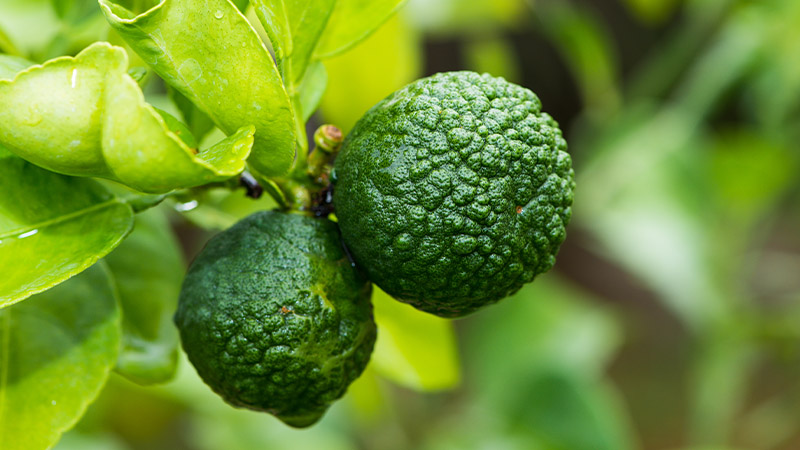What is it?
The kaffir lime is a dark green citrus fruit akin to the regular lime but with a rough, bumpy skin.The plant has a double leaf, the lower part oval in shape and the upper lobe pointed and connected to it by a “waist”. When freshly picked, the leaf’s surface is shiny and replete with essential oils, making the leaf the richest and most aromatic part of the plant. The leaf size varies from less than an inch when new (bright green) to several inches (darker green) when mature; the mature leaves are usually preferred for cooking.

The flavour
The leaves and grated zest of the lime lend a citrusy, herbal, astringent flavour and an almost floral aroma and are preferred over the fruit itself, which yields little juice. Most people do not actually eat the leaf unless they are young and tender and finely sliced into slivers for use in dishes such as Thai fish cakes or salads. Just one or two leaves are enough to flavour a pot of soup, for example tom yum goong. The leaves can be frozen for many months without losing flavour.
Where can you find it?
At wet markets and in the refrigerated vegetable section of most supermarkets.
Health benefits
- The essential oils in the leaves, thought to have therapeutic benefits, are extracted and used for bath products (toss in a few lightly crushed leaves for a naturally scented bath) and shampoos, with the added benefit that the lime aroma is believed to have a positive mental uplifting effect
- The extract of the plant helps increase the circulation of the blood and like all members of the citrus family acts anti-bacterial and anti-inflammatory
- It’s thought to be a mosquito repellent, like other plants such as citronella and turmeric
Cooking it at home
- Stuff quartered whole Kaffir limes and garlic inside the poultry cavity and gently slide the leaves under the skin before basting with butter and roasting in order to infuse a refreshing citrus and garlicky flavour
- When cooking jasmine rice, throw in a few bruised leaves and some coconut milk along with the water and then cook as normal to impart a fresh aroma and delicately creamy taste to the rice.
Recipe: Zingy Kaffir Lime Sorbet
Sorbets are frozen, whipped syrups with a scoop-able texture due to the use of significant quantities of sugar, which lowers the freezing point of the base. This gives the sorbet an almost creamy consistency despite its being dairy-free and fat-free.
Serves 6
Ingredients
- 3½ cups water; or try coconut water (not milk) for a different twist
- Pinch of salt
- 12 Kaffir lime leaves, slightly bruised in your palm
- 3 tablespoons fresh calamansi juice (from about six calamansi limes, depending on size)
- 1 cup of caster sugar
- 1 Tbsp finely grated lime rind (from 2 limes) for decoration
Method
1. In a small saucepan, put water, salt, sugar and the bruised lime leaves. Start with cold ingredients to extract the most from these aromatic flavours. Bring to a simmer, stirring to dissolve the sugar.
2. When the leaves have faded to a dull olive green, take the pot off the heat and allow to cool (to speed this process put pan in an ice bath).
3. If using an ice-cream maker, allow the mixture to cool completely and then refrigerate it until cold. (I cheated by putting the ice-bath-cooled liquid in the freezer for an hour.)
4. Add the calamansi juice, adjusting the amount to suit your taste.
5. Add mixture to ice-cream maker and start to churn. If you don’t have an ice cream maker, you can freeze it in a shallow dish for about 45 minutes, or until ice crystals form around the edge. Using a fork, stir the crystals and refreeze until crystals reform. Stir again and freeze for another hour, stirring every 15 minutes or so until all the juice is frozen.
6. If using an ice-cream maker, freeze the churned sorbet for an hour or so before serving; this will improve the texture. To serve, scoop into martini glasses, tuck in 2 leaves at the side and top with grated zest.
An aromatic and refreshing palate cleanser, or a sophisticated yet simple dessert. (Add a glug or two of vodka or cachaça for an adults-only take.)
Don't miss out on the latest events, news and
competitions by signing up to our newsletter!
By signing up, you'll receive our weekly newsletter and offers which you can update or unsubscribe to anytime.



